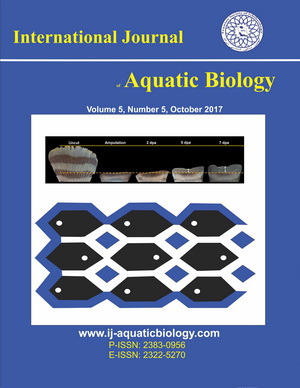Converting agricultural and fisheries waste into high-value products: Utilization of pea meal and shrimp protein hydrolysate as feed components for Nile Tilapia (Oreochromis niloticus)
Downloads
This study aims to characterize pea meal and shrimp protein hydrolysate as alternative protein ingredients, replacing soybean meal (SBM) in tilapia feed. The presence of protease inhibitors and the in vitro digestion were evaluated for both raw and extruded pea meals, while the characteristics of shrimp protein hydrolysate were also studied. The nutritional quality of alternative ingredients was assessed to formulate a diet that meets tilapia juveniles’ requirements, and its preliminary effects on growth were evaluated. Extrusion significantly reduced the inhibitory effect of pea meal on tilapia proteases (from 5.4 to 1.9%). In vitro, protein digestion of extruded pea meal (7.8±1.35%) did not differ from the control treatment with fish meal (11.8±1.94%). Additionally, shrimp protein hydrolysate presented 41.6±2.91% of DPPH radical scavenging activity. Tilapia fed a diet including 25% extruded pea meal and 10% shrimp protein hydrolysate, replacing soybean meal, presented comparable growth indicators to those exposed to the control diet. All the results in this study demonstrate that it is possible to include these ingredients derived from industrial waste in tilapia diets, improving the quality of the feed without affecting its performance.
Downloads
Abushweka A.A.M. (2018). Alternative protein sources as a replacement of fish meal in tilapia feeds. International Journal of Natural and Social Sciences, 6(5): 77-90.
Adler-Nissen J. (1986). Enzymic hydrolysis of food proteins. Elsevier Applied Science Publishers, London. https://doi.org/10.1016/0308-8146(87)90169-5
Anson M.L. (1938). The estimation of pepsin, trypsin, papain, and cathepsin with hemoglobin. Journal of General Physiology, 22(1): 79.
AOAC. (1997). Official method 994.12. Amino acids in feeds performic acid oxidation with acid hydrolysis sodium metabisulfite method. Washington, DC.
AOAC. (2013). Official methods of analysis 938.08. Fish and marine products. Ash of seafood. Association of Official Analytical Chemists, Washington, DC.
Baek H.H., Cadwallader K.R. (1995). Enzymatic hydrolysis of crayfish processing by?products. Journal of Food Science, 60(5): 929-935.
Boyd C.E., Tucker C.S. (2012). Pond aquaculture water quality management. Springer Science and Business Media.
Bradford M.M. (1976). A rapid and sensitive method for the quantitation of microgram quantities of protein utilizing the principle of protein-dye binding. Analytical Biochemistry, 72(1-2): 248-254.
Cao W., Zhang C., Hong P., Ji H., Hao J., Zhang J. (2009). Autolysis of shrimp head by gradual temperature and nutritional quality of the resulting hydrolysate. LWT-Food Science and Technology, 42(1): 244-249.
Diermayr P., Dehne L. (1990). Kontrollierte enzymatische Proteinhydrolyse im Bereich niedriger pH-Werte. I, Mitteilung: Versuche mit Rinderserumalbumin. Zeitschrift für Lebensmittel-Untersuchung und Forschung, 190(6): 516-520.
Egerton S., Wan A., Murphy K., Collins F., Ahern G., Sugrue I., … Stanton C. (2020). Replacing fishmeal with plant protein in Atlantic salmon (Salmo salar) diets by supplementation with fish protein hydrolysate. Scientific Reports, 10(1): 4194.
El-Sayed A.F., Nmartinez I., Moyano F.J. (2000). Assessment of the effect of plant inhibitors on digestive proteases of Nile tilapia using in vitro assays. Aquaculture International, 8: 403-415.
Fadel A.H., Kamarudin M.S., Romano N., Ebrahimi M., Saad C.R., Samsudin A.A. (2017). Carob seed germ meal as a partial soybean meal replacement in the diets of red hybrid tilapia. Egyptian Journal of Aquatic Research, 43(4): 337-343.
FAO. (2023). Nile Tilapia: Nutritional requirements. Retrieved from http://www.fao.org/fishery/affris/ species-profiles/nile-tilapia/nutritional-requirements/en Accessed 15 Oct 2023.
García-Carreño F.L. (1992). The digestive proteases of langostilla (Pleuroncodes planipes, Decapoda): their partial characterization, and the effect of feed on their composition. Comparative Biochemistry and Physiology B Biochemistry, 103(3): 575-578.
Gbogouri G.A., Linder M., Fanni J., Parmentier M. (2004). Influence of hydrolysis degree on the functional properties of salmon byproducts hydrolysates. Journal of Food Science, 69(8): C615-C622.
Gisbert E., Fournier V., Solovyev M., Skalli A., Andree K.B. (2018). Diets containing shrimp protein hydrolysates provided protection to European sea bass (Dicentrarchus labrax) affected by a Vibrio pelagius natural infection outbreak. Aquaculture, 495: 136-143.
González?Zamorano M., Navarrete del Toro M.A., García?Carreño F.L. (2013). Exogenous proteinases as feed supplement for shrimp: in vitro evaluation. Aquaculture Nutrition, 19(5): 731-740.
IndexMundi. (2023). Index Mundi Commodity Prices. Retrieved from https://www.indexmundi.com/commo d ities/?commodity=soybean-meal&months=240. Access ed 15 Oct 2023.
Javaherdoust S., Yeganeh S., Amirkolaie A.K. (2020). Effects of dietary visceral protein hydrolysate of rainbow trout on growth performance, carcass composition, digestibility and antioxidant enzyme in juvenile Oncorhynchus mykiss. Aquaculture Nutrition, 26(1): 134-144.
Khieokhajonkhet A., Muichanta S., Aeksiri N., Ruttarattanamongkol K., Rojtinnakorn J., Kaneko G. (2021). Evaluation of sacha inchi meal as a novel alternative plant protein ingredient for red hybrid tilapia (Oreochromis niloticus × O. mossambicus): growth performance, feed utilization, blood biochemistry, and histological changes. Animal Feed Science and Technology, 278: 115004.
Leal A.L.G., de Castro P.F., de Lima J.P.V., de Souza Correia E., de Souza Bezerra R. (2010). Use of shrimp protein hydrolysate in Nile tilapia (Oreochromis niloticus, L.) feeds. Aquaculture International, 18: 635-646.
Li S., Dai M., Qiu H., Chen N. (2021). Effects of fishmeal replacement with composite mixture of shrimp hydrolysate and plant proteins on growth performance, feed utilization, and target of rapamycin pathway in largemouth bass, Micropterus salmoides. Aquaculture, 533: 736185.
Ma Z., Boye J.I., Hu X. (2017). In vitro digestibility, protein composition and techno-functional properties of Saskatchewan grown yellow field peas (Pisum sativum L.) as affected by processing. Food Research International, 92: 64-78.
Magbanua T.O., Ragaza J.A. (2022). Selected dietary plant-based proteins for growth and health response of Nile tilapia Oreochromis niloticus. Aquaculture and Fisheries. https://doi.org/10.1016/j.aaf.2022.04.001
NRC. (2011). Nutrient requirements of fish and shrimp. The National Academies Press, Washington, DC, 9(3): 220-228.
Pereira N.D.L.A., Fangio M.F., Rodriguez Y.E., Bonadero M.C., Harán N.S., Fernández?Gimenez A.V. (2022). Characterization of liquid protein hydrolysates shrimp industry waste: Analysis of antioxidant and microbiological activity, and shelf life of final product. Journal of Food Processing and Preservation, 46(8): e15526.
Pradhan C., Divi B.G., Dileep N., Peter N., Sankar T.V. (2020). Replacement of soya bean meal with cashew nut meal as an alternative protein source in the diet of tilapia, Oreochromis mossambicus. Aquaculture Research, 51(4): 1660-1672.
Qi M., Zhang G., Ren Z., He Z., Peng H., Zhang D., Ma C. (2021). Impact of extrusion temperature on in vitro digestibility and pasting properties of pea flour. Plant Foods for Human Nutrition, 76: 26-30.
Ribéreau S., Aryee A.N., Tanvier S., Han J., Boye J.I. (2018). Composition, digestibility, and functional properties of yellow pea as affected by processing. Journal of Food Processing and Preservation, 42(1): e13375.
Ruttanapornvareesakul Y., Ikeda M., Hara K., Osako K., Kongpun O., Nozaki Y. (2005). Effect of shrimp head protein hydrolysates on the state of water and denaturation of fish myofibrils during dehydration. Fisheries Science, 71: 220-228.
Schulz C., Wickert M., Kijora C., Ogunji J., Rennert B. (2007). Evaluation of pea protein isolate as alternative protein source in diets for juvenile tilapia (Oreochromis niloticus). Aquaculture Research, 38(5): 537-545.
Shimada K., Fujikawa K., Yahara K., Nakamura T. (1992). Antioxidative properties of xanthan on the autoxidation of soybean oil in cyclodextrin emulsion. Journal of Agricultural and Food Chemistry, 40(6): 945-948.
Tallentire C.W., Mackenzie S.G., Kyriazakis I. (2018). Can novel ingredients replace soybeans and reduce the environmental burdens of European livestock systems in the future? Journal of Cleaner Production, 187: 338-347.
Wang N., Daun J.K., Malcolmson L.J. (2003). Relationship between physicochemical and cooking properties, and effects of cooking on antinutrients, of yellow field peas (Pisum sativum). Journal of the Science of Food and Agriculture, 83(12): 1228-1237.
Xiao W., Li D.Y., Zhu J.L., Zou Z.Y., Yue Y.R., Yang H. (2018). Dietary valine requirement of juvenile Nile tilapia, Oreochromis niloticus. Aquaculture Nutrition, 24(1): 315-323.
Yasumaru F., Lemos D. (2014). Species specific in vitro protein digestion (pH-stat) for fish: method development and application for juvenile rainbow trout (Oncorhynchus mykiss), cobia (Rachycentron canadum), and Nile tilapia (Oreochromis niloticus). Aquaculture, 426: 74-84.
Copyright (c) 2025 International Journal of Aquatic Biology

This work is licensed under a Creative Commons Attribution 4.0 International License.








